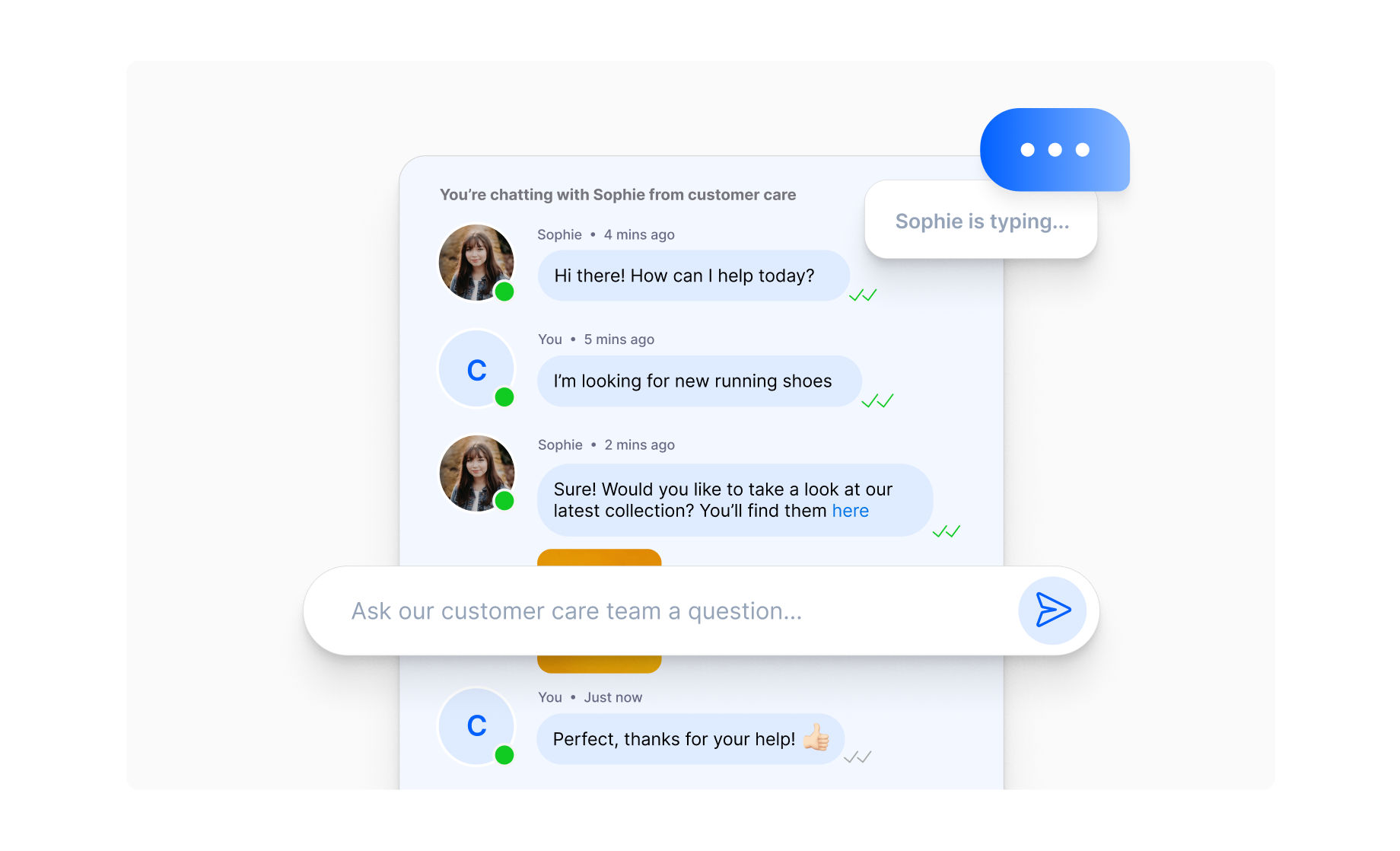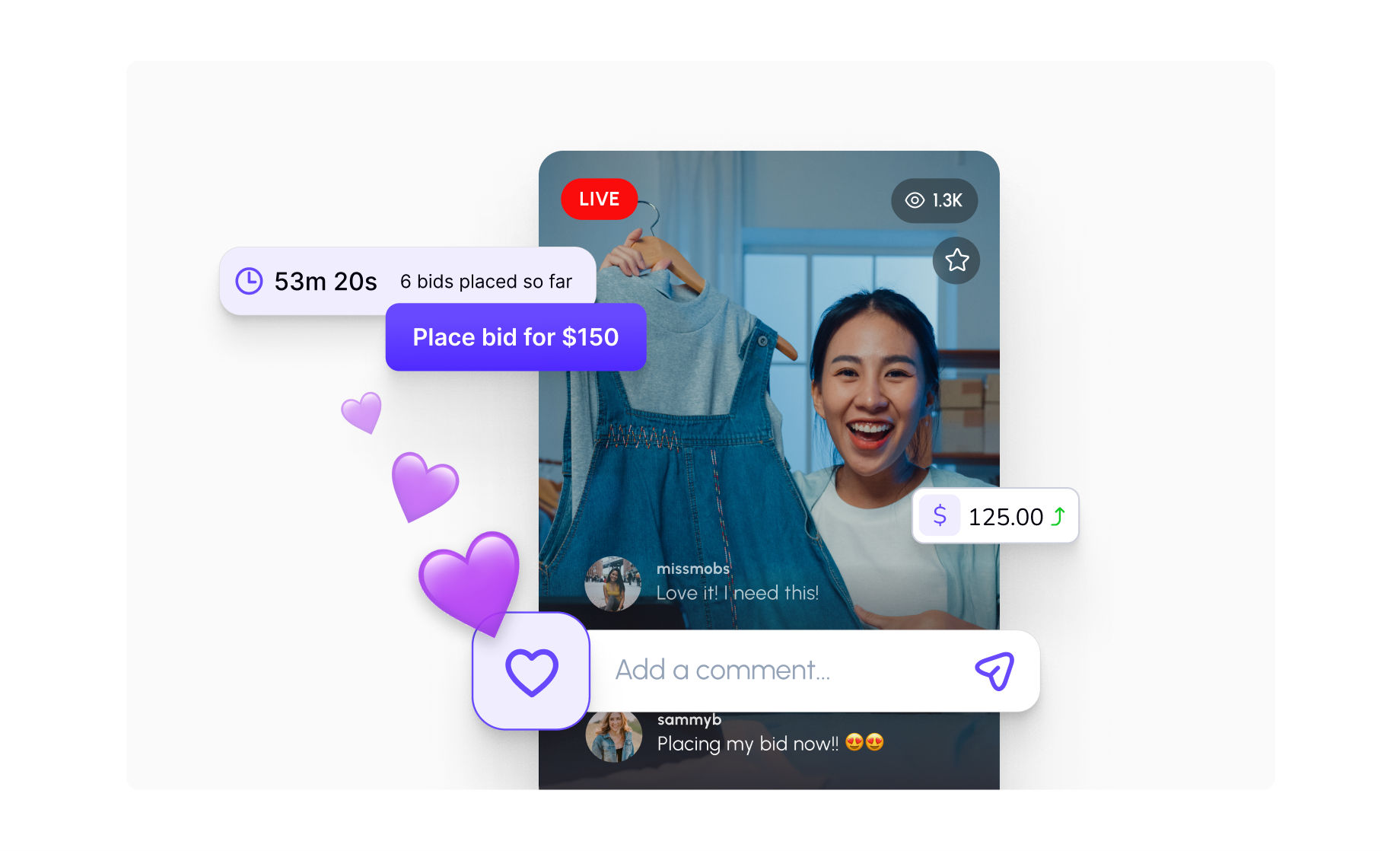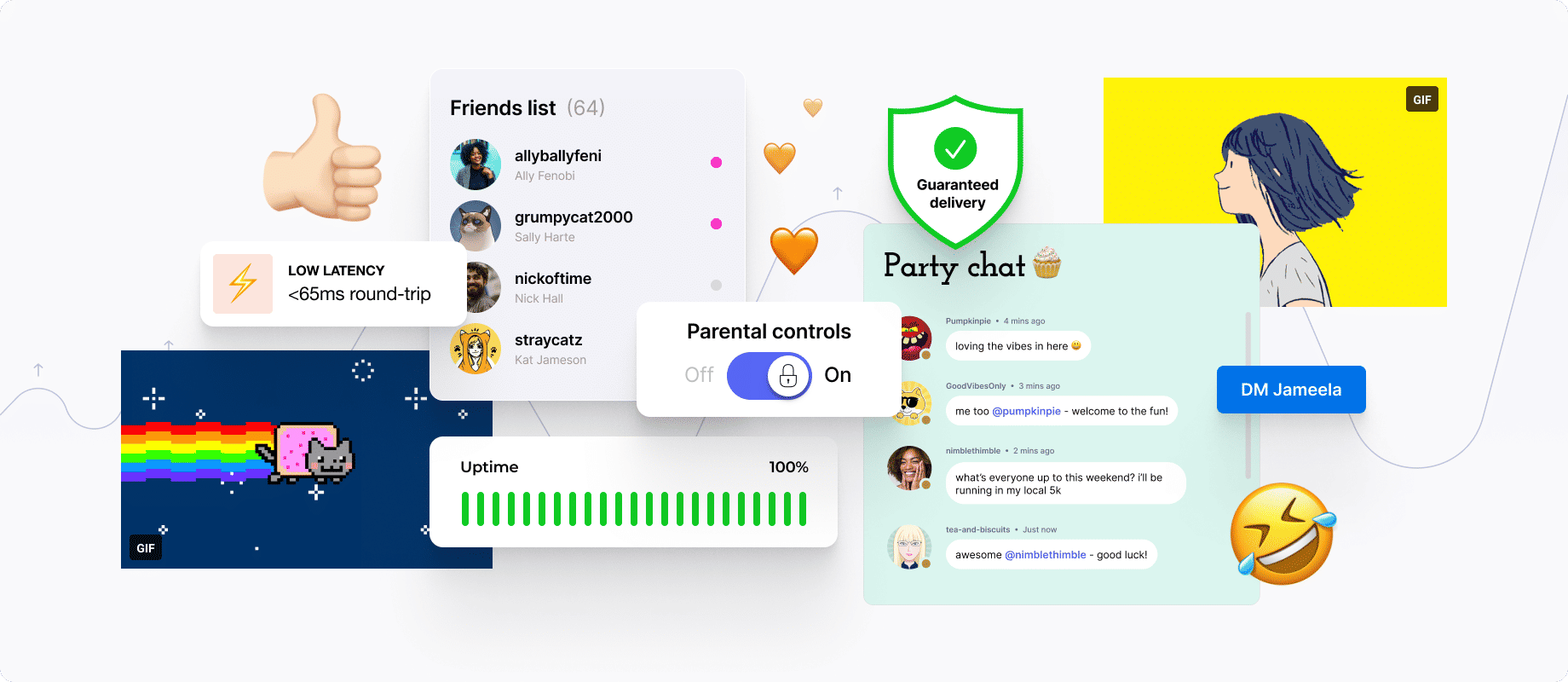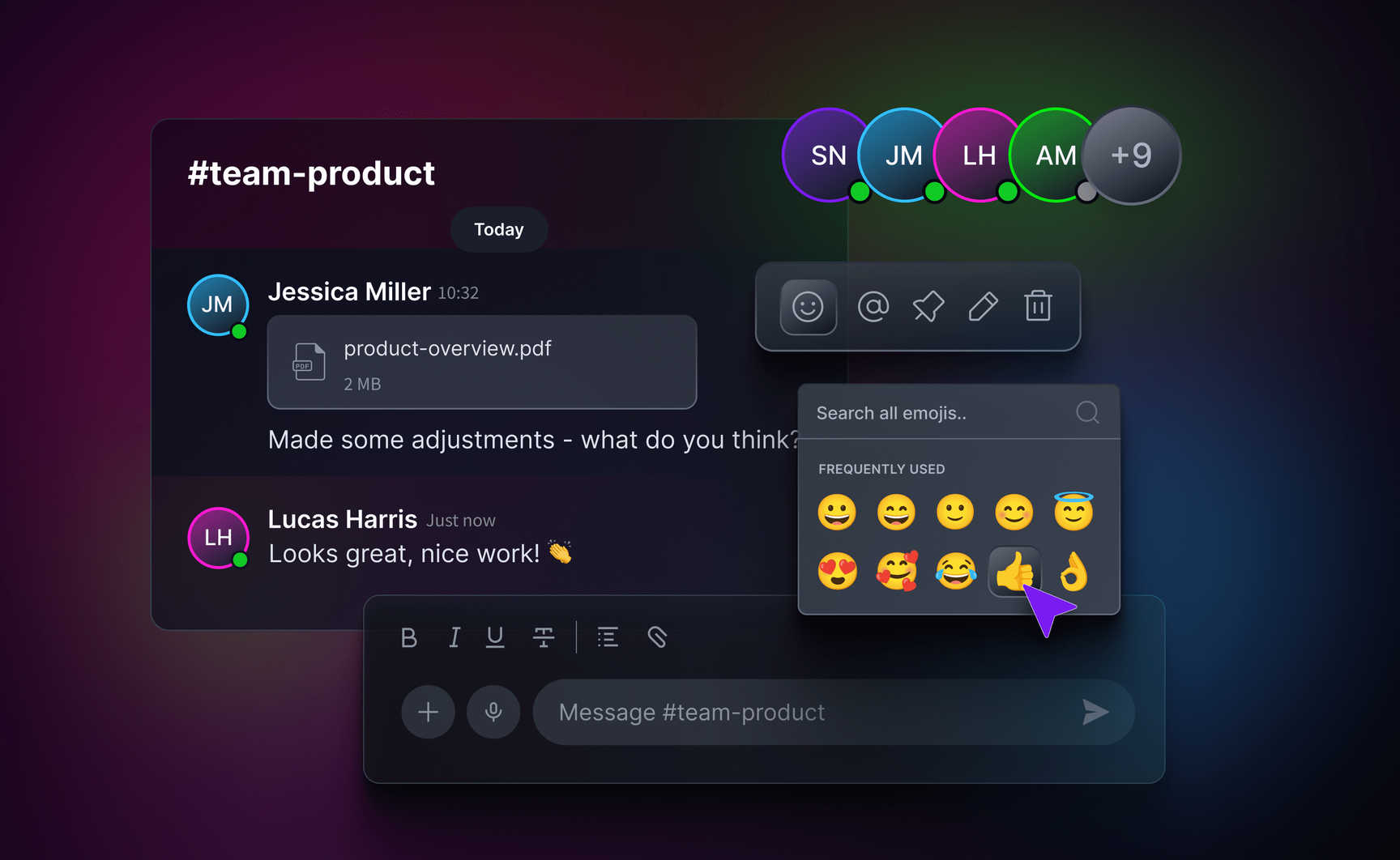Spring 2025 Update: We've recently launched Ably Chat, a new product that significantly simplifies building chat experiences on the Ably platform. Ably Chat comes with purpose-built APIs for realtime messaging, presence tracking, typing indicators, and reactions. Explore how you can build engaging chat experiences faster and easier. Learn more about Ably Chat →
In our previous post, we provided the ultimate live chat features list - covering 15 features you should provide in your live chat or instant messaging app.
Here, we cover how these features come to life across customer service, gaming, internal company chat, social and community chat, and chat for two-sided marketplaces.
Customer service live chat features
Poorly implemented customer service live chat can result in reduced customer satisfaction, and increased pressure on customer service representatives.

Here are three examples of how correctly implemented live chat - with the required infrastructure and front-end features - can make or break the customer service experience.
Low latency message delivery
One of the main reasons customers get annoyed when using live chat to access customer support is the feeling that they are out of touch with what’s happening. Lagging and unreliable chats make it especially difficult because neither the customer or customer service agent can be sure if and when their messages are delivered.
When HubSpot set out to offer a live chat service for customers to use in customer service scenarios, they made low latency and reliability a priority. Today, more than 128,000 businesses across the world use HubSpot’s live chat to communicate in realtime. With 80,000 live chats each day and 3 billion messages per month, HubSpot’s customers indirectly rely on Ably’s realtime infrastructure to deliver messages on time, every time.
Automatic reconnection
In North America, customers are as likely to contact your live chat on a mobile device as they are a laptop or desktop computer. That brings with it the variability of cell networks as opposed to a fixed line domestic or office connection.
When a rail passenger uses their bank’s in-app live chat to query a transaction, or when a retail customer gets in-touch about an existing order whilst they are in a car, connectivity issues shouldn't derail the conversation. Instead, the app should keep the user informed and attempt to reconnect automatically.
File and image sharing
It’s a different type of customer service, but live chat is increasingly used as a first step in medical diagnosis via Digital GPs. That’s especially true in remote areas such as the Australian outback where primary medical care is often a plane flight away. Patients can use live chat to send doctors images of their own medical conditions in order to help the medic decide whether an in-person consultation is necessary.
Two way marketplace live chat features
Live auctions and marketplaces with concurrent live chat are increasingly popular. Bringing together complete strangers in a largely pseudononymous environment can bring with it some challenges, though.

Let’s look at some of the features that can help with live chat in this scenario.
Targeted messages
Targeted messages alert individual users when their name is mentioned. For auctions and other two sided marketplaces, targeted messages can provided the basic infrastructure necessary. For example, when someone gets outbid, a targeted message can let them know immediately. Similarly, buyers and sellers can message each other to dive into the detail of a particular product and to ask questions that aren’t answered elsewhere.
Moderation
Moderation is an essential part of pretty much all live chat. When voice chat first became technically possible it was mostly used in gaming. Quickly, it became easy for anonymous, young players to use insulting and highly offensive language. Not only did this make the experience unpleasant for most players but it also opened a potential liability for the games publishers.
A similar temptation exists for trolls active on live chat, whether text or voice based, in two sided marketplaces. Through human moderators, machine learning tools, and the ability for users to block or report other people, moderation makes live chat usable and more enjoyable.
Internal company live chat features
Live chat has become the communication backbone not only of remote-first companies, but also for organizations that previously might have used synchronous meetings or email more heavily.
Perhaps more so than any other live chat use case, team communication needs live chat to be unobtrusive until that person’s attention is needed.
To take on that central role in corporate communication, live chat needs to let team members focus on the chat only when they absolutely need to. And when it acts as a record of decisions taken in meetings, the ability to edit or delete inaccurate messages is essential.
Push notifications
Push notifications and live chat for teams go hand in hand. Take Slack, for example. It offers varied levels of notification that enable people to control how engaged they want to be on a channel by channel basis. In the case of engineering teams using a channel for service interruption alerts, everyone on pager duty might want to get a push notification. But maybe not so much from the joke of the day channel.
Message editing and deletion
Live chat has gone from a tool used on the fringes of companies to become the communication method of record in many organizations. As such, it’s important that the record is accurate.
For globally distributed teams, getting together at a time that makes sense for everyone can be tough. Live chat provides a way for team members to share what they’ve done, what they plan to do, and where they’re blocked without having to be on a voice or video call. But with how easy it is to make a typo or mistate something, those daily stand-up messages could become harder to read and less useful to the rest of the team. As simple as it seems, the ability to delete and edit messages transforms live chat from a peripheral tool to become a team’s primary communication channel.
In-game live chat features
Gaming has evolved from being a largely solo activity to becoming a key part of the social lives of players. In fact, 80% of gamers say it helps them to meet new people. And in-game chat is at the heart of enabling that social connection.

Titles such as Fortnight, Minecraft, and Roblox bring players together in realtime through text chat, voice chat, and even video chat. Unlike chat for work environments or commercial transactions, that means in-game chat must focus on providing a healthy ongoing social environment as well as tying into the specific play mechanics of each game.
Two live chat features that are especially important for in-game chat are parental controls and friends lists.
Parental controls
Even face to face, the heat of competitive gameplay can lead to indelicate language on the sports field. In a virtual space, the temptation for players to lose their temper or taunt their competitors can be amplified by anonymity and the seeming disconnect between their actions and real world consequences. That makes moderation particularly important for in-game chat. However, as many players are minors, parental control is one of the most impactful forms of moderation.
Parental controls for in-game chat come in two types: access restrictions and filtering.
Epic Games, makers of Fortnite and Rocket League, enable parents to set fine grained restrictions on what their children can access. For example, allowing children to voice chat only with existing friends rather than anybody in the game.
Even when access is restricted, there’s still the risk of exposure to inappropriate language. Many titles, such as popular fantasy roleplaying game Runescape, let parents set a profanity filter on in-game chat, which automatically removes offensive words or replaces them with asterisks.
Friends lists
With the social aspects of gaming being so important, games can succeed or fail based on how well players can find, manage, and engage with their friends. Whether it’s a simple word game or an immersive role playing game, the friends list plays a role in chat, finding people to play with, teaming-up on campaigns, and in enabling functionality such as the parental controls we looked at a moment ago.
Social and community live chat features
Community is all about sustaining an ongoing connection between people. Since the earliest days of the internet, live chat has brought friends and strangers together to converse in realtime. And although the ability to speak to almost anyone anywhere is a great advantage of online chat, the sheer scale of it can make it harder for people to find one another and to find their place.
There are two live chat features that are particularly important to making online communities humans-scale: channels and online status.
Channels
Channels are crucial to the success of social and community live chat. Most community chat services enable both private and public channels. Public channels bring people together around a shared topic, making it easier for chat users to find the conversations that meet their interests.
Over time, those channels might develop their own cultures and rules, developing into a sub-community of their own. In some cases, channels might move on from their original theme as they become defined more by the connections between their long-term users than the original theme. In such cases, a private channel might be more appropriate.
Online status
One of the challenges of live chat is replicating the social cues of in-person conversation. Online status is one way of setting expectations of when individuals might respond, what their current mood is, and more. Many chat services automatically mark users as “away” or “active”, depending on whether they’re currently engaged with the chat. Others allow users greater control over their status.
By helping chat users to bridge the gap between in-person conversation and online chat, online status indicators help to build connections between people and contribute towards that community’s culture.
Here, we've looked at how live chat features come to life across different use cases. This is how it looks in practice across 11 creative, real-world examples.




